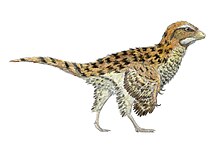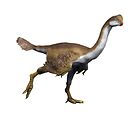Eosinopteryx
| Eosinopteryx Temporal range: Late Jurassic,
| |
|---|---|

| |
| Life restoration | |
| Scientific classification | |
| Kingdom: | Animalia |
| Phylum: | Chordata |
| Clade: | Dinosauria |
| Clade: | Saurischia |
| Clade: | Theropoda |
| Family: | †Anchiornithidae |
| Genus: | †Eosinopteryx Godefroit et al., 2013 |
| Type species | |
| †Eosinopteryx brevipenna Godefroit et al., 2013
| |
Eosinopteryx is an extinct genus of theropod dinosaurs known to the late Jurassic period of China. It contains a single species, Eosinopteryx brevipenna.[1]
Classification[]
E. brevipenna is known from a single fossil specimen recovered from the Tiaojishan Formation of western Liaoning Province, China, which has been dated to the late Jurassic period (Oxfordian age), about 160 million years ago.[2][3] The name Eosinopteryx is derived from the Greek eos ("daybreak" or "dawn"), the Latin Sinae ("Chinese"), and the Greek pteryx ("feather"). The specific name brevipenna (from the Latin brevis, "short", and penna, "feather") refers to the reduced plumage preserved in the type specimen, YFGP-T5197.[1]
Though initially classified as a troodontid,[1] a more comprehensive analyses of its relationships have found it to be either a primitive paravian or an avialan.[4] In 2017 re-evaluation of the Harlem Archaeopteryx specimen, Eosinopteryx is found to be an anchiornithid.[5]
Description[]
Eosinopteryx brevipenna is known from a single fossil specimen representing the nearly complete skeleton of a subadult or adult individual. The specimen is very small for a non-avialan dinosaur, measuring about 30 centimetres (12 in) long. Unlike most troodontids, the snout was very short, shorter than the diameter of the eye socket. The wings were about the same size as those of the related Anchiornis huxleyi, with the primary wing feathers being longer than the humerus (upper arm bone). An unusual arrangement of the wing bones would have prevented any flapping motion.
The tail was very short compared to most troodontids and dromaeosaurids and also unlike members of those groups, the feet and toes were very slender, lacking highly curved claws for predation or climbing. Unusually, the tail of the only known fossil does not show signs of the presence of complex vaned feathers (rectrices), and the lower tarsals and feet appear to have been featherless, unlike many related species with "hind wings" on the lower legs and feet.[1]
A researcher from the University of Southampton said in 2013 the discovery of Eosinopteryx suggests "that the origin of flight was much more complex than previously thought".[6]
External links[]
- A photograph of the type specimen, published by David Evans' twitter account
- A close-up view of the skull, from the same source
References[]
- ^ a b c d Godefroit, P.; Demuynck, H.; Dyke, G.; Hu, D.; Escuillié, F. O.; Claeys, P. (2013). "Reduced plumage and flight ability of a new Jurassic paravian theropod from China". Nature Communications. 4: 1394. Bibcode:2013NatCo...4.1394G. doi:10.1038/ncomms2389. PMID 23340434.
- ^ Hu, D.; Hou, L.; Zhang, L. & Xu, X. (2009). "A pre-Archaeopteryx troodontid theropod from China with long feathers on the metatarsus". Nature. 461 (7264): 640–643. Bibcode:2009Natur.461..640H. doi:10.1038/nature08322. PMID 19794491.
- ^ Liu Y.-Q.; Kuang H.-W.; Jiang X.-J.; Peng N.; Xu H.; Sun H.-Y. (2012). "Timing of the earliest known feathered dinosaurs and transitional pterosaurs older than the Jehol Biota". Palaeogeography, Palaeoclimatology, Palaeoecology. 323–325: 1–12. doi:10.1016/j.palaeo.2012.01.017.
- ^ Lefèvre, U.; Hu, D.; Escuillié, F. O.; Dyke, G.; Godefroit, P. (2014). "A new long-tailed basal bird from the Lower Cretaceous of north-eastern China". Biological Journal of the Linnean Society. 113 (3): 790–804. doi:10.1111/bij.12343.
- ^ Foth, C.; Rauhut, O.W.M. (2017). "Re-evaluation of the Haarlem Archaeopteryx and the radiation of maniraptoran theropod dinosaurs". BMC Evolutionary Biology. 17 (1): 236. doi:10.1186/s12862-017-1076-y. PMC 5712154. PMID 29197327.
- ^ "Feathered dinosaur puts theory in doubt". 3 News NZ. January 25, 2013.
- Late Jurassic dinosaurs of Asia
- Prehistoric paravians
- Fossil taxa described in 2013
- Feathered dinosaurs
- Taxa named by Pascal Godefroit
- Paleontology in Liaoning
- Jurassic birds
- Theropod stubs















